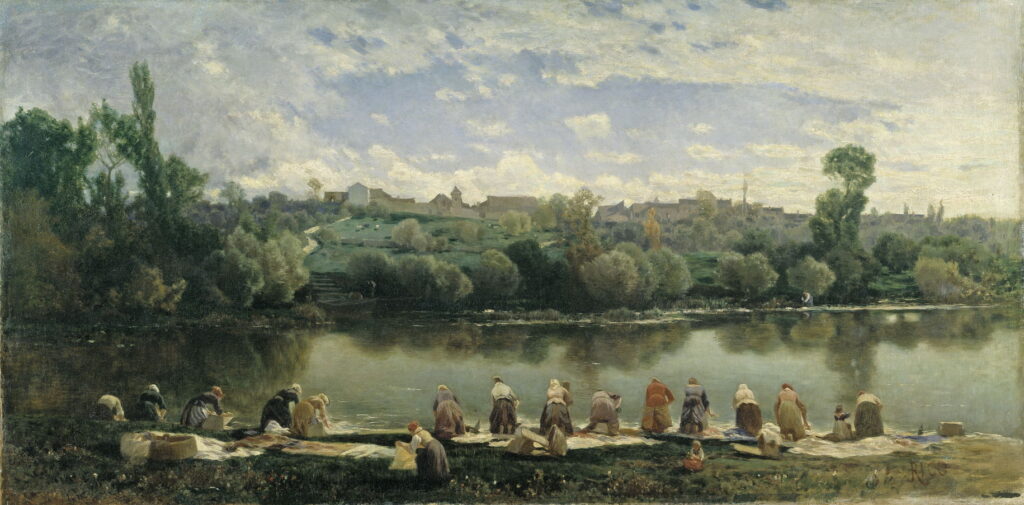Laundresses in a landscape 1

Until well into the twentieth century, running water was what came through the roof when it rained, and didn’t come from a tap. Although only the rich could afford to wear clothes for short periods and expect them to be laundered, soiled clothing and linen still had to be washed, normally in the nearest outdoor body of water. This weekend I’m celebrating the many centuries that women washed clothes outdoors, and were painted as part of the landscape. This first article covers the period up to the height of Impressionism at the end of the 1870s, and tomorrow’s resumes in 1880 and concludes in the early twentieth century.
Pierre-Salomon Domenchin de Chavanne (1673–1744), Landscape with Washerwomen (date not known), oil on canvas, dimensions not known, Musée des Beaux-Arts, Rennes, France. Image by Caroline Léna Becker, via Wikimedia Commons.
Pierre-Salomon Domenchin de Chavanne’s Landscape with Washerwomen, probably from around 1700-20, shows a common sight, as do many early landscapes: a small group of women have taken sheets and clothes in large wicker baskets to a small lake, and are washing them as well as they can.
Alessandro Magnasco (1667–1749), Landscape with Washerwomen (1710-20), oil on canvas, 73.2 x 57.8 cm, Museum of Fine Arts, Houston, TX. Wikimedia Commons.
Alessandro Magnasco’s Landscape with Washerwomen (1710-20) shows a similar scene, the women having walked down from the town glimpsed in the distance. At the lower left is a man out hunting with his dog and gun.
Louis-Gabriel-Eugène Isabey (1803-1886), The Town and Harbour of Dieppe (1842), oil on canvas, dimensions not known, Musée des beaux-arts de Nancy, Nancy, France. Image by Ji-Elle, via Wikimedia Commons.
On a grey day of showers in 1842, the major French landscape artist Eugène Isabey caught laundresses at work above The Town and Harbour of Dieppe. There’s a second group at the extreme left edge whose washing looks in danger of being blown away over the town below.
Henri Harpignies (1819–1916), A View of Moulins (c 1850-60), graphite and watercolour on heavy wove paper, 31.7 x 51 cm, Metropolitan Museum of Art, New York, NY. Wikimedia Commons.
Henri Harpignies had initially learned to paint in oils, but from 1851 also took to watercolour. He painted this dawn View of Moulins in watercolour between about 1850-60, close to the dead centre of France. This looks over the Allier River, past the line of washerwomen on its far bank, towards the spires and towers of the town whose linen was being cleaned in that river.
Johan Jongkind (1819–1891), Le Pont de la Tournelle, Paris (1859), oil on canvas, 143.5 x 219.1 cm, The Legion of Honor, Fine Arts Museums of San Francisco, San Francisco, CA. Wikimedia Commons.
By this time, in northern France, the move towards Impressionism was just starting. The landscape painter Johan Jongkind returned to Paris in 1859, where he painted this view of Le Pont de la Tournelle, Paris (1859), with a small group of washerwomen at work by the water’s edge.
The bridge shown here had been built in 1654, to replace a series of predecessors from the first in 1620. It connects the city to the south with the Île Saint-Louis, which had originally been two smaller islands close to the Île Notre Dame, on which the cathedral stands. Jongkind isn’t interested in the market for topographic paintings, though, and his attention is on the washerwomen and the old bridge.
Martín Rico (1833–1908), Washerwomen of Varenne (1865), oil on canvas, 85 x 160 cm, location not known. Wikimedia Commons.
By the late nineteenth century, with the growth of towns and cities, laundry had became more organised, as shown in Martín Rico’s Washerwomen of Varenne (1865). A group of fifteen women, some with babies and children, are on the bank of the local river, most of them probably performing this as a commercial service, as it was one of the few occupations open to women of the lower classes. For Rico they transform his landscape with their activity and the rhythm of their figures.
Eugène Boudin (1824–1898), Washerwoman near Trouville (1872-76), oil on panel, 27.6 x 41.3 cm, National Gallery of Art, Washington, DC. Wikimedia Commons.
Working women are also featured in some of Eugène Boudin’s painterly oil sketches made in front of the motif, such as this of Washerwoman near Trouville from 1872-76. This laundress appears to be beating her washing with a mallet to drive the dirt out.
Berthe Morisot (1841–1895), Hanging the Laundry out to Dry (1875), oil on canvas, 33 × 40.6 cm, The National Gallery of Art, Washington, DC. Wikimedia Commons.
In the early years of the Impressionist movement, Berthe Morisot’s Hanging the Laundry out to Dry (1875) shows a communal drying area at the edge of a town. The women have a large black cart to transport the washing, and are busy putting it out on the lines to dry in the sunny spells. Next to that area is a small allotment where a man is growing vegetables, and in the distance are the chimneys of the city.
Alfred Sisley (1839–1899), Washerwomen near Champagne (1879), oil on canvas, 60 by 73 cm, location not known. Wikimedia Commons.
While most of Alfred Sisley’s landscapes are relatively unpopulated, he also experimented with introducing more figures into the foreground of some, including this riverside view of Washerwomen near Champagne from 1879. They appear to have brought their washing down to the water in wicker baskets, on an ancient wheelbarrow.




